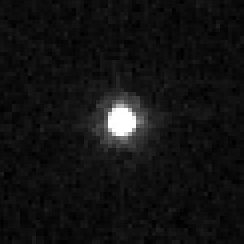|
471143 Dziewanna
471143 Dziewanna (provisional designation 2010 EK139) is a trans-Neptunian object in the scattered disc, orbiting the Sun in the outermost region of the Solar System. Dziewanna was discovered on 13 March 2010 by astronomers Andrzej Udalski, Scott Sheppard, Marcin Kubiak and Chad Trujillo at the Las Campanas Observatory in Chile.[1] Based on its absolute magnitude and assumed albedo, it is estimated to have a diameter of approximately 470 kilometers.[6] It was named after Devana (Polish form: Dziewanna), a Slavic goddess of the wilderness, forests and the hunt,[1] in honor of the fact that it was discovered during the Polish OGLE project of Warsaw University, which was led by Udalski.[11] Distance  Dziewanna orbits the Sun at a distance of 32.6 to 108.3 AU once every 591 years and 4 months (215,992 days). Its orbit has an eccentricity of 0.54 and an inclination of 29° with respect to the ecliptic.[3] It is currently 39.1 AU from the Sun and will reach perihelion in 2038.[3][10] A ten-million-year integration of the orbit shows that this object is in a 2:7 resonance with Neptune.[4] A precovery image was taken by the Near-Earth Asteroid Tracking at Palomar Observatory in 2002. This extends Dziewanna's observation arc to 8 years prior to discovery. It has since been observed 143 times over 6 oppositions and has an orbit quality of 1.[1] Physical propertiesIn 2010, the thermal radiation of Dziewanna was observed by the Herschel Space Telescope, which allowed astronomers to estimate its diameter at about 470 km (290 mi).[6] A stellar occultation by Dziewanna was observed on 17 May 2019, yielding a single-chord diameter of 504 km (313 mi).[7] A rotational lightcurve was obtained from photometric observations at the discovering observatory, with the 2.5-meter Irénée du Pont Telescope, and published in May 2013. The lightcurve shows that the rotation period is 7.07±0.05 hours; the variation in brightness is of magnitude 0.12 (U=2).[9] Observations by American astronomer Michael Brown at the Keck telescope in March 2012 failed to find a satellite. There is therefore currently no means to determine Dziewanna's mass.[6] See alsoReferences
External links
|
||||||||||||||||||||||||||||||||||||||||||||||||||||||||||||||||||||||


